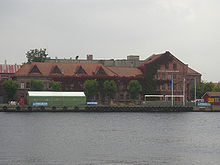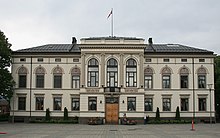Porsgrunn
| coat of arms | map | |
|---|---|---|

|
|
|
| Basic data | ||
| Commune number : | 3806 | |
| Province (county) : | Vestfold and Telemark | |
| Administrative headquarters: | Porsgrunn | |
| Coordinates : | 59 ° 7 ' N , 9 ° 43' E | |
| Surface: | 164.45 km² | |
| Residents: | 36,397 (Feb 27, 2020) | |
| Population density : | 221 inhabitants per km² | |
| Language form : | Bokmål | |
| Postal code : | 3901 | |
| Website: | ||
| traffic | ||
| Railway connection: | * Eidanger – Brevik * Vestfoldbanen |
|
| politics | ||
| Mayor : | Robin Martin Kåss ( Ap ) (2015) | |
| Located in the province of Vestfold og Telemark | ||

|
||
is an important port and industrial city in the south of theprovince of Vestfold og Telemark(Norway). Theindependentmunicipality,located160 km fromOsloon the Norwegian south coast,reachesits highest pointinFjerdingen(360 meters). The districts ofEidangerandBrevikwere incorporated in 1964.
Porsgrunn received its coat of arms on December 13, 1904 from the Swedish-Norwegian King Oskar II . A plant branch symbolizes the Gagelstrauch , Norwegian "Pors", which gave the place its name. The anchor stands for shipping; the silver sloping beam represents the river Porsgrunnselva .
history
Porsgrunn has been mentioned since the 16th century, but did not grow as a timber handling center until 1600. In 1807 the place received market rights, in 1842 it became a town. In the 19th century, industrialization brought shipbuilding to Porsgrunn; Between 1866 and 1880 alone, 103 ships left the local shipyards . Traditionally, larger sawmills also played a decisive role in the city's economic development.
An economic stagnation around 1880 led to new entrepreneurial initiatives. The porcelain manufactory Porsgrund Porselænsfabrik was founded in 1885 with capital from shipping circles . The factory, which is still the only one of its kind in Norway and known nationwide, has been manufacturing goods for domestic use since 1887. Together with its museum, it is now considered the city's most important tourist attraction. It was based on the German model and in the first few years attracted skilled workers from Germany and Bohemia . Even before 1900 she was a major employer, not least employing many women - a novelty at the time.
From 1929 onwards, heavy industry in particular shaped the city . On the Herøya peninsula , a few km southwest of the center, the Norsk Hydro group had an artificial fertilizer factory built as early as 1929 . It has been operated by the former Hydro subsidiary Yara since 2004 and, after various modifications, is one of the largest of its kind in the world. At the beginning of the 1950s, Norsk Hydro also built a magnesium factory on Herøya , which was converted into a modern smelter for scrap metal recycling in 2002 . Not far from the factory, Norsk Hydro has been producing various qualities of PVC since 1951 . Further factories on Herøya make the island the largest industrial complex in Norway to this day.

traffic
Porsgrunn has a train station on Vestfoldbane .
Educational institutions
Porsgrunn has also been an important location for educational institutions since the late 19th century. In 1884, Skiensfjordens Tekniske Fagskole , a technical college that was successful until 1972, was founded. Today, Høgskolen i Telemark ( Telemark University), established in 1994, has one of its four locations in Porsgrunn; Among other things, it enables engineering training including a doctorate . A commercial college and nursing training are also affiliated.
Twin cities
sons and daughters of the town
- Cort Adeler (1622–1675), Dutch-Norwegian admiral
- Jacob Aall (1773–1844), theologian, historian and politician
- Severin Løvenskiold (1777–1856), factory owner and politician
- Jørgen Juve (1906–1983), football player
- Jahn Otto Johansen (1934–2018), journalist and writer
- Mads Gilbert (* 1947), doctor and political activist
- Hans Andreas Limi (* 1960), politician
- Kjersti Wold (* 1962), writer
- Bugge Wesseltoft (* 1964), jazz musician
- Stein Erik Lauvås (* 1965), politician
- Anita Valen de Vries (* 1968), racing cyclist
- Monica Valvik-Valen (* 1970), racing cyclist
- Thorstein Aaby (1971-2007), guitarist
- Bård Hoksrud (* 1973), politician
- Tommy Svindal Larsen (* 1973), football player
- Fredrik Brattberg (* 1978), composer and playwright
- Ella Gjømle (* 1979), cross-country skier
- Kjetil Lie (* 1980), chess grandmaster
- Kari Henneseid Eie (* 1982), biathlete
- Anja Hammerseng-Edin (* 1983), handball player
- Rune Almenning Jarstein (* 1984), soccer player
- Aleksander Walmann (* 1986), singer
- Didrik Solli-Tangen (* 1987), pop singer
- Herolind Shala (* 1992), soccer player


